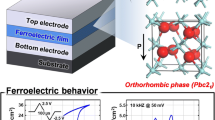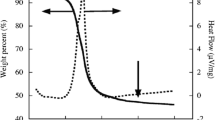Abstract
Single crystalline Ni gradient–diameter magnetic nanowire arrays (GDMNWs) with different D/d (the diameter of thick end (D) and thin end (d) of GDMNWs) were successfully prepared by constant potential electrodeposition into a tapered anodic aluminum oxide template. The TEM images of samples illustrated that the obvious gradient–diameter nanowires had been obtained. The HRTEM, SAED images and XRD pattern demonstrated that the nanowire arrays grew with Ni single crystal structures. The magnetic interaction of GDMNWs was investigated by first-order reversal curves (FORCs) and δM(H) plots. The FORCs diagrams and δM(H) plots of different D/d ratio were compared and indicated that the magnetic interaction of GDMNWs with a thin end was dominated by dipolar interaction, and the thick end was dominated by exchange interaction. There was a gradient overlap effect in dipolar interaction and exchange interaction between the thin end and thick end. The spatial distributions of such unique magnetic interaction of GDMNWs were likely to produce entirely new physical characteristics of memory effect and tunable ferromagnetic resonance.







Similar content being viewed by others
References
Kwak M, Han L, Chen JJ, Fan R (2015) Interfacing inorganic nanowire arrays and living cells for cellular function analysis. Small 11:5600–5610
Garcia JM, Asenjo A, Velazquez J, Garcia D, Vazquez M, Aranda P, RuizHitzky E (1999) Magnetic behavior of an array of cobalt nanowires. J Appl Phys 8:5480–5482
Huber CA, Huber TE, Sadoqi M, Lubin JA, Manalis S, Prater CB (1994) Nanowire array composites. Science 263:800–802
Singh R (2013) Unexpected magnetism in nanomaterials. J Magn Magn Mater 346:58–73
Hrkac G, Dean J, Allwood DA (2011) Nanowire spintronics for storage class memories and logic. Phys Eng Sci 369:3214–3228
Xu C, Li Z, Yang C, Zou P, Bi Xie, Lin Z, Zhang Z, Li B, Kang F, Wong CP (2016) An ultralong, highly oriented nickel-nanowire-array electrode scaffold for high-performance compressible pseudocapacitors. Adv Mater 28:5769–5777
Carignan LP, Yelon A, Ménard D, Caloz C (2011) Ferromagnetic nanowire metamaterials: theory and applications. IEEE T Microw Theory 59:2568–2585
Zhang WX, Yang SH (2009) In situ fabrication of inorganic nanowire arrays grown from and aligned on metal substrates. Acc Chem Res 42:1617–1627
Martin CR (1996) Membrane-based synthesis of nanomaterials. Chem Mater 8:1739–1746
Parkin SP, Hayashi M, Thomas L (2008) Magnetic domain-wall racetrack memory. Science 320:190–194
Wang J, Zuo Z, Huang L, Warsib MA, Xiao JQ, Hu J (2018) Novel gradient-diameter magnetic nanowire arrays with unconventional magnetic anisotropy behaviors. Chem Commun 54:7515–7519
Proenca MP, Sousa CT, Ventura J, Garcia J, Vazquez M, Araujo JP (2017) Identifying weakly-interacting single domain states in Ni nanowire arrays by FORC. J Alloys Compd 699:421–429
Diao Z, Decorde N, Stamenov P, Rode K, Feng G, Coey JMD (2012) Magnetization processes in micron-scale (CoFe/Pt)n multilayers with perpendicular anisotropy: first-order reversal curves measured by extraordinary Hall effect. J Appl Phys 111:07B538
Pan M, Li Z, Wu Q, Ge H, Xu H (2019) Study of the role of Ti doping on magnetic properties of some nanocomposite alloys of α-Fe/Nd2Fe14B type. J Magn Magn Mater 471:457–463
Lyubina J, Müller KH, Wolf M, Hannemann U (2010) A two-particle exchange interaction model. J Magn Magn Mater 322:2948–2955
Pan H, Liu B, Yi J, Poh C, Lim S, Ding J, Feng Y, Huan CHA, Lin J (2005) Growth of single-crystalline Ni and Co nanowires via electrochemical deposition and their magnetic properties. J Phys Chem B 109:3094–3098
Hertel R, Kirschner J (2004) Magnetization reversal dynamics in nickel nanowires. Phys B 343:206–210
Dobrot CI, Stancu A (2013) What does a first-order reversal curve diagram really mean? A study case: Array of ferromagnetic nanowires. J Appl Phys 113:043928
Mayergoyz I (1986) Mathematical models of hysteresis. IEEE Trans Magn 22:603–608
Muxworthy AR, King JG, Heslop D (2005) Assessing the ability of first-order reversal curve (FORC) diagrams to unravel complex magnetic signals. J Geophys Res 110:B01105
Gilbert DA, Zimanyi GT, Dumas RK, Winklhofer M, Gomez A, Eibagi N, Vicent JL, Liu K (2014) Quantitative decoding of interactions in tunable nanomagnet arrays using first order reversal curves. Sci Rep 4:4204
Dobrota CI, Stancu A (2015) Tracking the individual magnetic wires’ switchings in ferromagnetic nanowire arrays using the first-order reversal curves (FORC) diagram method. Phys B Condens Matter 457:280–286
Maurer T, Zighem F, Fang W, Ott F, Chaboussant G, Soumare Y, Atmane KA, Piquemal JY, Viau G (2011) Dipolar interactions in magnetic nanowire aggregates. J Appl Phys 110:123924
Elbaile L, Crespo RD, Vega V, Garcia JA (2012) Magnetostatic interaction in Fe–Co nanowires. J Nanomater 1:198453
Pardavi-Horvath M, Si PE, Vazquez M, Rosa WO, Badini G (2008) Interaction effects in Permalloy nanowires systems. J Appl Phys 103:07D517
Kou XM, Fan X, Zhu H, Xiao JQ (2009) Tunable ferromagnetic resonance in NiFe nanowires with strong magnetostatic interaction. Appl Phys Lett 94:112509
Kou XM, Fan X, Dumas RK, Lu Q, Zhang YP, Zhu H, Zhang XK, Liu K, Xiao JQ (2011) Memory effect in magnetic nanowire arrays. Adv Mater 23:1393–1397
Acknowledgements
This work was supported by the National Natural Science Foundation of China (51672248 and 51872261), Zhejiang Natural Science Foundation Outstanding Youth Science Foundation (LR19E020002) and Public Project of Zhejiang Province (2017C37067).
Author information
Authors and Affiliations
Corresponding authors
Ethics declarations
Conflict of interest
The authors declare that they have no conflict of interest.
Additional information
Publisher's Note
Springer Nature remains neutral with regard to jurisdictional claims in published maps and institutional affiliations.
Rights and permissions
About this article
Cite this article
Xu, J., Wang, J., Hong, B. et al. Growth and magnetic interaction of single crystalline Ni gradient–diameter magnetic nanowire arrays. J Mater Sci 54, 11538–11545 (2019). https://doi.org/10.1007/s10853-019-03694-3
Received:
Accepted:
Published:
Issue Date:
DOI: https://doi.org/10.1007/s10853-019-03694-3




